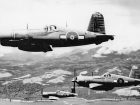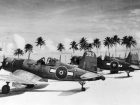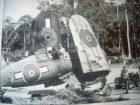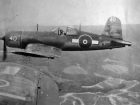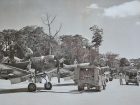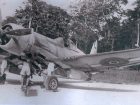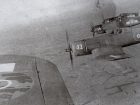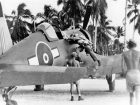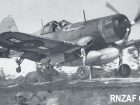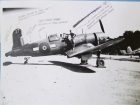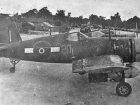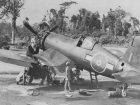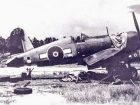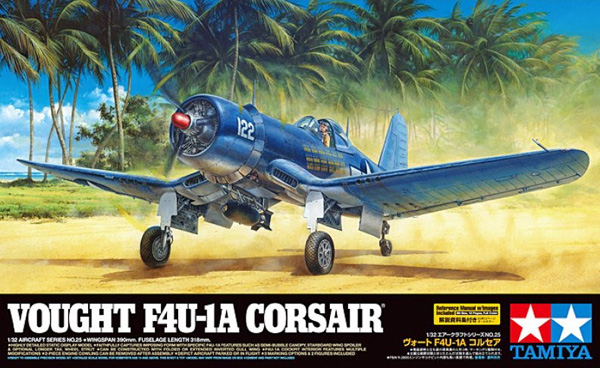
Full Review by Dave Coward
A note from Geoff…
Again, Dave has been working at his usual incredible speed and still maintaining outstanding quality that’s demonstrated in the few taster photos that follow showing his completed project. One of your best to date Dave in my opinion – really exceptional weathering and painting – congratulations on a stunning outcome!
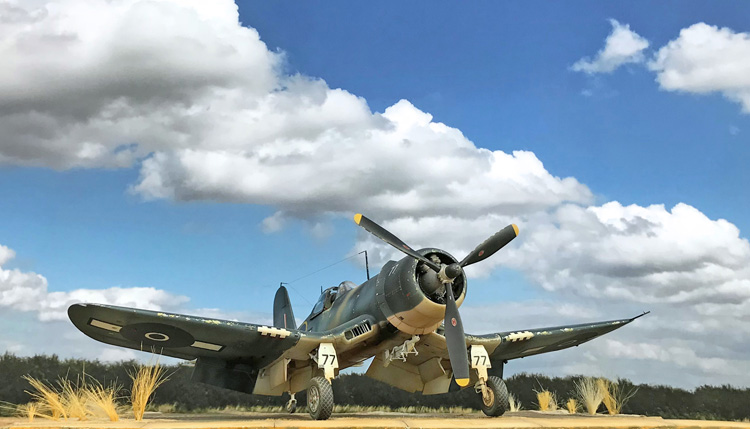
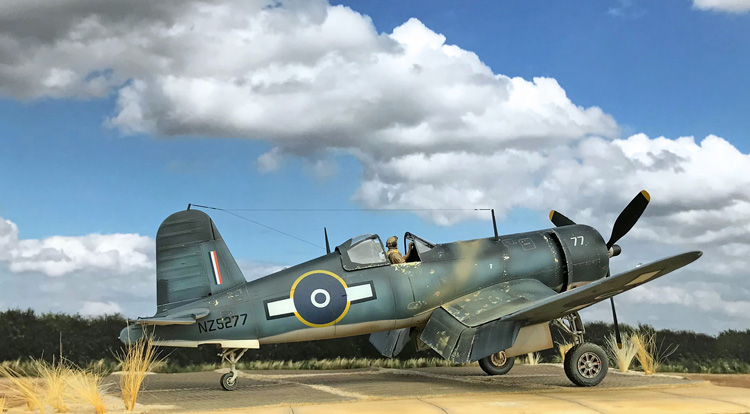
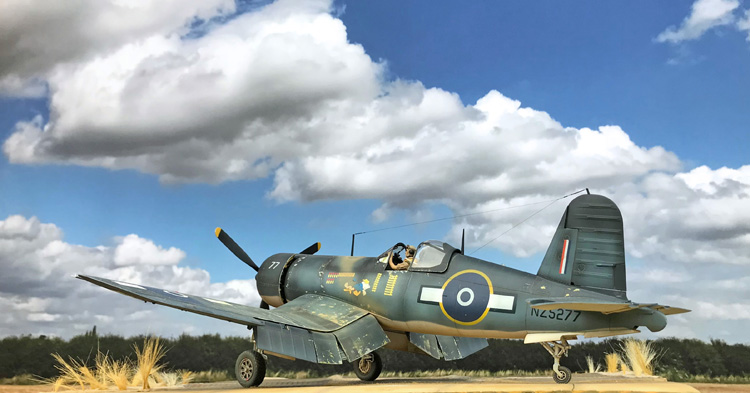
Background
The Vought F4U Corsair is an American fighter aircraft that saw service primarily in World War II and the Korean War. Demand for the aircraft soon overwhelmed Vought’s manufacturing capability, resulting in production by Goodyear and Brewster: Goodyear-built Corsairs were designated FG and Brewster-built aircraft F3A. From the first prototype delivery to the U.S. Navy in 1940, to final delivery in 1953 to the French, 12,571 F4U Corsairs were manufactured, in 16 separate models, in the longest production run of any piston-engined fighter in U.S. history (1942–53).
The Corsair was designed as a carrier-based aircraft but it’s difficult carrier landing performance rendered it unsuitable for Navy use until the carrier landing issues were overcome by the Royal Navy Fleet Air Arm. The Corsair thus came to and retained prominence in its area of greatest deployment: land based use by the U.S. Marines. The role of the dominant U.S. carrier based fighter in the second part of the war was thus filled by the Grumman F6F Hellcat, powered by the same Double Wasp engine first flown on the Corsair’s first prototype in 1940 The Corsair served to a lesser degree in the U.S. Navy. In addition to its use by the U.S. and British, the Corsair was also used by the Royal New Zealand Air Force, the French Naval Aviation and other, smaller, air forces until the 1960s. Some Japanese pilots regarded it as the most formidable American fighter of World War II, and the U.S. Navy counted an 11:1 kill ratio with the F4U Corsair.
After the carrier landing issues had been tackled, it quickly became the most capable carrier-based fighter-bomber of World War II.
Royal New Zealand Air Force Corsairs
Rather than do the usual US navy or Marines F4U I decide on something a little different for this build and chose an aircraft belonging to the Royal New Zealand Air Force.
Equipped with obsolete Curtiss P-40s, Royal New Zealand Air Force (RNZAF) squadrons in the South Pacific performed impressively compared to the American units they operated alongside, in particular in the air-to-air role. The American government accordingly decided to give New Zealand early access to the Corsair, especially as it was not initially being used from carriers. Some 424 Corsairs equipped 13 RNZAF squadrons, including No. 14 Squadron RNZAF and No. 15 Squadron RNZAF, replacing Douglas SBD Dauntlesses as well as P-40s. Most of the F4U-1s were assembled by Unit 60 with a further batch assembled and flown at RNZAF Hobsonville. In total, there were 336 F4U-1s and 41 F4U-1Ds used by the RNZAF during the Second World War. Sixty FG-1Ds arrived late in the war.
The first deliveries of lend-lease Corsairs began in March 1944 with the arrival of 30 F4U-1s at the RNZAF Base Depot Workshops (Unit 60) on the island of Espiritu Santo in the New Hebrides. From April, these workshops became responsible for assembling all Corsairs for the RNZAF units operating the aircraft in the South West Pacific; and a Test and Despatch flight was set up to test the aircraft after assembly. By June 1944, 100 Corsairs had been assembled and test flown. The first squadrons to use the Corsair were 20 and 21 Squadrons on Espiritu Santo, operational in May 1944. The organization of the RNZAF in the Pacific and New Zealand meant that only the pilots and a small staff belonged to each squadron (the maximum strength on a squadron was 27 pilots): squadrons were assigned to several Servicing Units (SUs, composed of 5-6 officers, 57 NCOs, 212 airmen) which carried out aircraft maintenance and operated from fixed locations: hence F4U-1 NZ5313 was first used by 20 Squadron/1 SU on Guadalcanal in May 1944; 20 Squadron was then relocated to 2 SU on Bougainville in November. In all there were ten front line SUs plus another three based in New Zealand. Because each of the SUs painted its aircraft with distinctive markings and the aircraft themselves could be repainted in several different colour schemes, the RNZAF Corsairs were far less uniform in appearance compared with their American and FAA contemporaries. By late 1944, the F4U had equipped all ten Pacific-based fighter squadrons of the RNZAF.
By the time the Corsairs arrived, there were very few Japanese aircraft left in New Zealand’s allocated sectors of the Southern Pacific, and despite the RNZAF squadrons extending their operations to more northern islands, they were primarily used for close support of American, Australian, and New Zealand soldiers fighting the Japanese. At the end of 1945, all Corsair squadrons but one (No. 14) were disbanded. No. 14 Squadron was given new FG-1Ds and in March 1946 transferred to Iwakuni, Japan as part of the British Commonwealth Occupation Force with the Corsair being retired from service in 1947.
Only 1 airworthy example of the 437 aircraft procured survives: FG-1D NZ5648/ZK-COR, owned by the Old Stick and Rudder Company at Masterton, NZ.
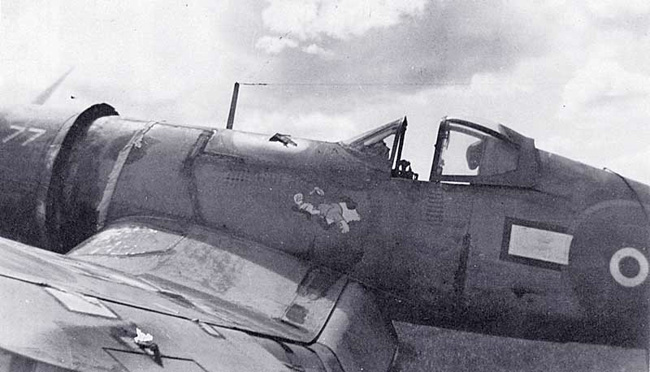
F4U-1A NZ5277
Of all the NZ Corsairs, I decided to do NZ5277 due to its great nose art, it’s very worn paint scheme and the fact I could easily obtain masks for it from Montex. Some details about this aircraft are listed below.
Colours were originally the standard US Navy ‘4 Tone’ scheme of Non-Specular (matt) Sea Blue upper fuselage, Semi-Gloss Sea Blue wing and tail plane upper surfaces, Intermediate Blue fuselage sides and tail fin/rudder and wing undersides outboard of the wing fold. The undersides were Insignia White. All of these were matt finish except for the upper wing surfaces which when fresh, were semi-gloss. These colours soon faded to a grey blue hue when in service up in the Islands
NZ5277 5116 F4U-1 Bu49866. Shipped from USA on 19 April 1944 aboard “USS Breton”. Assembled in Espiritu Santo and BOC Unit 60 on 05 May 1944. Issued to No.15 Fighter Squadron, Guadalcanal on 18 May 1944. Coded “77”. To No.14 Squadron on 08 August 1944. Badly damaged in taxying accident with NZ5275 at Kukum Field on 17 August 1944 but repaired and returned to service. To No.16 Squadron on 21 December 1944. To No.21 Squadron by April 1945. Damaged on 24 July 1945 but repaired and returned to service by September. Ferried to New Zealand in October 1945. Advertised for sale by WARB tender number 1704 and sold from Rukuhia to J. Larsen, Palmerston North on 02 March 1948.
